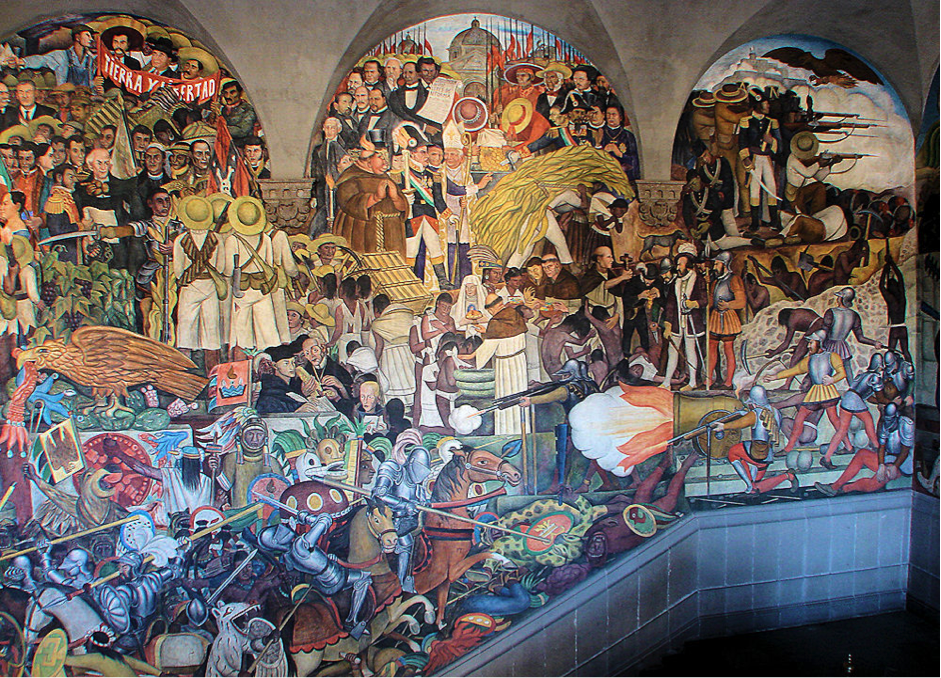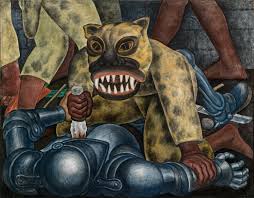Diego Rivera: the individual expression of collective emotions
By Nicola Popovic
Strolling along Berlin, it is impossible to overlook the numerous graffitis and, after all, mural art work visible at every street corner. Public art, which is what mural art has developed into, is part of our everyday media consumption, walking to the bus station or waiting at a traffic light. Political views and discussions are exchanged through symbols, words, and paintings, on walls and on buildings, in many cities around the globe.
In Berlin, the most prominent example of mural art is the accumulation over decades of layers of paintings and graffitis on the Berlin wall, the symbol of the division between two political ideologies, regimes and economic systems as it took place in one city. As shown by the Wall on Wall project, the Berlin wall, the Peace Line in Belfast, or the wall in Palestine are examples of dividing constructions which have been re-used as visual platforms for individual expressions of collective emotions concerning such disunion.
Art may become political in the public sphere. It often addresses issues that are collective in nature and relevant to its viewers. It may expose collective trauma, movements, discourses, and it may divide people.
One of the most influential artists of the 20th century, well-known for his mural work about political regimes, culture, social classes and struggles, is Diego Rivera. The Mexican painter combines intellectual discourse with Native American expressions and views on collective suffering. His mural work shows oppression and liberation movements by the Mexican people, but also struggles within ideologies, history and multi-cultural clashes.
Part Of Diego Rivera’s Mural Depicting Mexico’s History – 1929-1945
After studying in Europe where he met other artists such as Chagall, Picasso and Modigliani, he returned to Mexico to study Aztec and Mayan art. He also became more and more involved in the Mexican Communist movement. Being himself caught in a struggle between political beliefs and activism, between a European artistic education and Native American cultural expressions and narratives, socialist ideology and US capitalist art production, he unifies different sources that nurture the socio-political discourse of the Mexican people in the global context of the early 20th century: the moment of its struggle for independence.
Being both fascinated and disgusted by the capitalist regime in place in the northern part of the continent, Rivera had several well-paid assignments that sparked public controversy. His work at the Radio Corporation Arts Building in Rockefeller Center, for example was even destroyed, due to the presence of Lenin’s head in the painting. His paintings and actions claimed absolute freedom of expression and called for participation in the political discourse through his mural work in the public sphere.
One can see in his painting the unique combination of different peoples mixing into Latin American identity, as it touches on cubism and post-impressionism, native story telling (as known through Maya and Aztec art work), and the symbolism of political critical expressionism. Through the way in which an artist works with colors, motives, and the combination of both, factors that influence a collective experience such as trauma can be read in the art work of an individual. Diego Rivera sets high standards when it comes to possible interpretations of mural art. As in the case of Pablo Picasso’s Guernica, the mural works of Diego Rivera are an expression of the trauma experienced by a nation in a conflict as it tries to redefine its collective identity. The artist, through his work, makes a statement about emotions of a community he is not necessarily a part of.
When being exposed in the public sphere, art immediately attempts to integrate and interact with the public. Rivera not only expresses his personal opinion about the tensions between East and West, colonial European interventions and Native Americans, but is also the Zeitgeist of a decade. He documents history in its socio-political context through emotional expressions and therefore captures and at the same time influences collective memory of a conflict and trauma.
The same documentation of trauma can be found today in walls that separate people, buildings that scrape the sky, train stations, traffic signs and construction sites. They give to read the interpretations by an individual of a collective perception of realities, movements and social changes. Strolling along Berlin, these re-transcriptions can be read, drawn on a wall that separates and at the same time unites us, documenting different dimensions of a collective we may or may not be part of.
Indian Warrior – 1931
Of all the panels Rivera made for The Museum of Modern Art, Indian Warrior reaches back farthest into Mexican history, to the Spanish Conquest of the early 16th century. An Aztec warrior wearing the costume of a jaguar stabs an armored conquistador in the throat with a stone knife. The Spaniard’s steel blade—an emblem of European claims to superiority—lies broken nearby. Jaguar knights, members of an elite Aztec military order, were known for their fighting prowess; according to legend, their terrifying costumes enabled them to possess the power of the animal in battle. The panel’s jarring vision of righteous violence offered a Mesoamerican precedent for Mexico’s recent revolution, as well as its continuing struggles.





Trackbacks & Pingbacks
[…] channels to convene ideas – a concept that Creating Rights strives to explore, for example here and here – the CICC Arts Initiative invites artists with a view to help create a dialogue […]
Comments are closed.